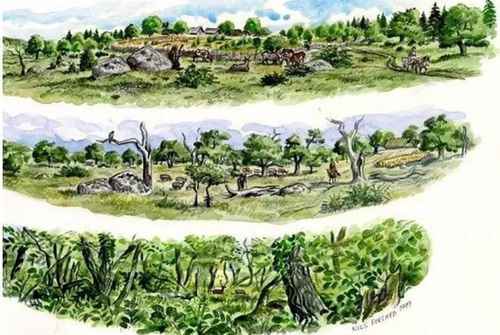▲ Illustration of paradigm changes from the time of early humans to the present day.Europe Press Pictures
European press
La Jornada newspaper
Saturday, March 2, 2024, p. 5
Madrid. Carbon isotope analysis of hazelnut shells found at archaeological sites makes it possible to reveal what the places where humans lived thousands of years ago looked like.
In a new study published in Frontiers in environmental archaeologyResearchers at the University of Oxford have devised a method of analyzing preserved hazelnut shells to indicate whether microhabitats around archaeological sites are densely wooded or open and grass-like.
This is based on the fact that hazelnuts grown in closed environments, such as dense, shaded forests, have very different carbon isotopes than hazelnuts grown in open, sunny environments. The new method can help us understand not only what the local environment was like thousands of years ago, but also how humans affected their habitats over time.
By analyzing carbon in hazelnuts recovered from archaeological sites in southern Sweden, ranging from Mesolithic hunter-gatherer camps to one of the largest and richest Iron Age settlements in northern Europe, we show that hazelnuts are increasingly being collected in open environments.
Lead author Dr Amy Steering from the University of Oxford said in a statement.
Humans in Northern Europe have used hazelnut trees as a source of materials and food for thousands of years. Nuts are an excellent source of energy and protein, can be stored for long periods and their shells can also be used as fuel.
Like all plants, hazelnuts contain carbon, which exists in different forms known as isotopes. The ratios of different carbon isotopes are changed by the relationship between carbon dioxide concentrations between leaf cells and the surrounding environment. In plants such as hazelnuts, this ratio is strongly affected by sunlight and water availability; In places where water is not scarce, such as in Sweden, sunlight affects the ratio more. When there are fewer trees competing for sunlight and photosynthesis rates are higher, hazelnut trees will have higher carbon isotope values.
To test whether this effect could be observed in archaeological samples, an international team from the University of Oxford and Lund University collected hazelnuts from trees growing in different light levels at three sites in southern Sweden. At the University of Oxford's Stable Isotope Laboratory, they then analyzed the variation in carbon isotope values of hazelnuts and the relationship between these values and the light levels to which the trees were exposed.
After determining these reference values, the researchers then studied the carbon isotope values of hazelnut shells from archaeological sites also located in southern Sweden.
They selected shell fragments from four Mesolithic sites and 11 sites ranging from the Neolithic to the Iron Age (covering a total period of about 9,000 years), some of which were inhabited in more than one period.
Using reference values and archaeological findings, the archaeologists ran a model to assign their hazelnut samples to one of three types of surrounding environment: closed, open, and semi-open. Because the carbon isotopes in an individual hazelnut will naturally differ somewhat from those in other species growing in similar environments, the scientists used multiple samples from each site and evaluated the proportion of hazelnuts that grew in enclosed or open environments.
Scientists have discovered that Mesolithic fruits were collected in more closed environments, while nuts from more recent periods were collected in more open environments. In the Iron Age, most of the people who collected hazelnut samples in this study collected them in open areas, not in forests. Their micro-habitats have completely changed.
This is consistent with environmental reconstructions from pollen analyses, but isotope analysis can be used to visualize a local environment where pollen records are rare.

“Social media evangelist. Student. Reader. Troublemaker. Typical introvert.”


:quality(85)/cloudfront-us-east-1.images.arcpublishing.com/infobae/7TXNTX4Z6ZADNGBBYTUT45QETM.jpg)
:quality(85)/cloudfront-us-east-1.images.arcpublishing.com/infobae/TR43PX4FQRCGJOYTK6DVVHHXGE.jpg)


More Stories
National Academy of Medicine and PAHO present reports of the Colombia General Physician Competency Forum – PAHO/WHO
Academic excellence in medical sciences is recognized at Granma.
Medical simulation has revolutionized the training of doctors in the country.